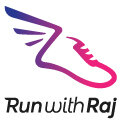As the weather warms up and the world begins to slowly reopen without a COVID-19 vaccine, it is all the more important to run safe. There has been confusion over whether runners should run with a mask and how much runners should distance themselves from others. I will share some research on both topics as well as five practical steps that runners should consider!
Running With a Mask
While the CDC recommends wearing a mask when out in public places, it has yet to address outdoor exercise. To my knowledge, there have not been any large-scale studies on transmission likelihood between people who are walking or running. But the consensus seems to be that runners should cover their faces when they exercise outside, especially when they expect to be near other people.
Several studies (1, 2, 3) show that masks reduce exposure to infection with varying degrees of effectiveness depending on type. Buffs are perhaps the most comfortable to cover the nose and mouth as they are breathable, sweat-wicking, and lightweight. But their synthetic material has a low filtration rate and does retain germs longer than cotton blend, tightly-woven fabrics or surgical masks. Find a balance between infection control and comfort -- something is better than nothing.
For those who have trouble breathing, running with a mask could exacerbate a medical condition if you can’t breathe as freely during movement. It’s okay to slow down and focus on breathing slowly and deeply from your belly.
Remember: masks alone aren’t enough and can give runners a false sense of security that it’s okay to run near others. Good hygiene and distancing should remain the first course of action.
Social Distancing When Running
A fluid dynamics study that was shared widely among the running community last month recommends keeping a distance of more than 13 feet and avoiding running directly behind or in the “slipstream” of another runner. The findings make intuitive sense: when you’re breathing hard and moving fast, more droplets could linger in the air over a longer distance.
This study focused on computerized simulations not accounting for outdoor effects such as sunlight, humidity, and wind, or epidemiological effects such as viral load—the amount of virus in your blood—necessary for infection. Another popular post by an immunologist suggests there is generally not enough time to achieve the infectious viral load when you are outside and 6 feet apart.
Virologists agree that the more often or longer you’re exposed, the greater your risk. This is why group running is currently not safe; you’re moving in a slipstream of others’ breaths for miles at a time. A solo runner passing someone who is infected can theoretically get sick from a single breath, but experts say the probability is low.
Runners’ “Do the Five”
Wear a mask or nose/mouth covering in public. Face coverings show you’re doing your part -- something is better than nothing.
Keep a distance of more than 6 feet from others. Social distancing is a proven way to prevent virus transmission.
Wash your hands before and after you run. Clean your hands with soap and water for 20 seconds or use a sanitizer with at least 60% alcohol.
Carry your own hydration and fuel. Outdoor fountains may be off or not a safe option, so BYO water and electrolytes.
Avoid running outside when sick. Don’t run when you are more likely to cough or sneeze, spread viral particles, and infect others.


